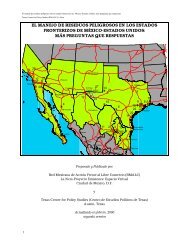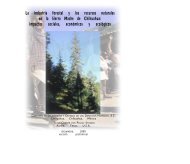Pesticides and Water Quality - Texas Center for Policy Studies
Pesticides and Water Quality - Texas Center for Policy Studies
Pesticides and Water Quality - Texas Center for Policy Studies
You also want an ePaper? Increase the reach of your titles
YUMPU automatically turns print PDFs into web optimized ePapers that Google loves.
TABLE 1.SUMMARY OF REVIEWDATA SOURCESURFACE WATER / DRINKING WATER1996 State <strong>Water</strong> <strong>Quality</strong> Inventory <strong>and</strong> STORET<strong>Water</strong> <strong>Quality</strong> Data Base (1984 – 1997)TNRCC, March 1998 § 303 (d) list of <strong>Water</strong>sFailing to meet Aquatic life use (1990 – 1994 data)<strong>Texas</strong> Department of Health, Fish Advisories <strong>and</strong>Bans, 1997.<strong>Texas</strong> Department of Health, Fish Tissue SamplingData (1970 – 1997).Public Drinking <strong>Water</strong> Sampling Database, TNRCC(1/93 – 3/98); includes quarterly sampling data <strong>for</strong>approximately 5000 systems.TNRCC, March 1998, § 303 (d) threatened list ofwaters.SUMMARY10 years of limited data on about 38 pesticides inwater, sediment <strong>and</strong> fish tissue. Most frequentlydetected pesticides include banned products such aschlordane, dieldrin, silvex <strong>and</strong> DDT <strong>and</strong> itsbreakdown products <strong>and</strong> currently used pesticidessuch as diazinon <strong>and</strong> 2,4-D. There were no resultsabove the detection limit <strong>for</strong> 22 of the 32 pesticidestested in water samples. There are no data <strong>for</strong> manyof the most widely used pesticides. TNRCC hasidentified twelve water body segments “of concern”due to pesticides in sediments <strong>and</strong> three “ofconcern” <strong>for</strong> pesticides in fish (mostly chlordane,DDT <strong>and</strong> breakdown products).Three river segments not meeting aquatic life usedue to elevated diazinon levels.Eleven river segments / lakes have fish consumptionadvisories or bans due to high pesticide levels infish tissue (primarily banned pesticides such aschlordane, toxaphene <strong>and</strong> DDT breakdownproducts).Limited <strong>and</strong> sporadic fish tissue sampling datashows several pesticides detected in fish tissueabove detection limits in water bodies across thestate – primarily, but not exclusively, highlypersistent banned pesticides (chlordane, DDT &breakdown products, toxaphene, dieldrin, endrin).Nine Public <strong>Water</strong> Systems (PWS) exceededatrazine maximum contaminant level (MCL)st<strong>and</strong>ards <strong>for</strong> drinking water at least once sincemonitoring began in 1993. One of these systemswas in violation of st<strong>and</strong>ard (average of quarterlysamples above MCL). In 1997, sixty four systemshad 107 detections of atrazine in finished water.<strong>Pesticides</strong> were detected in over 90 PWS systems,including simazine, alachlor, metolachlor, <strong>and</strong>others. (Appendix B)Nine lakes / reservoirs listed because atrazine foundin drinking water from these water bodies.4




